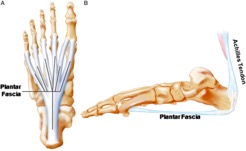
What is Plantar Fasciopathy?
 First and foremost, let talk about what the plantar fascia (PF) actually is. The PF is a strip of connective tissue that runs along the sole of your foot. It runs from the base of your toes all the way back to your calcaneus (heel bone) and some of the tissue even extend upwards into the achilles tendon. This is a critical component of the PF; as the achilles tension increases so does the PF tension (Cheung, Zhang & An, 2006). Fasciopathy develops when the cumulative load passing through the fascia exceeds the structural integrity of the tissue. This then causes degeneration of the tissue, usually on the inside of the heel, and pain as a result. This condition is particularly uncomfortable first thing in the morning, with the first few steps potentially feeling like there is a marble wedged into your foot.
First and foremost, let talk about what the plantar fascia (PF) actually is. The PF is a strip of connective tissue that runs along the sole of your foot. It runs from the base of your toes all the way back to your calcaneus (heel bone) and some of the tissue even extend upwards into the achilles tendon. This is a critical component of the PF; as the achilles tension increases so does the PF tension (Cheung, Zhang & An, 2006). Fasciopathy develops when the cumulative load passing through the fascia exceeds the structural integrity of the tissue. This then causes degeneration of the tissue, usually on the inside of the heel, and pain as a result. This condition is particularly uncomfortable first thing in the morning, with the first few steps potentially feeling like there is a marble wedged into your foot.
Potential Causes
There have been many studies conducted into the intrinsic and extrinsic factors that may increase the likelihood of developing plantar fasciopathy. These include some of the following:
-
Overuse to prolonged weight-bearing (excessive compression)
-
Obesity (excessive compression and load)
-
Unaccustomed increase in walking/running (excessive compression and load)
-
Reduced ankle dorsiflexion (excessive compression)
-
Posterior lower limb muscle tightness (excessive compression and load)
-
Standing on hard surfaces for prolonged periods (excessive compression)
-
Excessive foot pronation (excessive load)
-
Age (Reduction in tensile strength)
(Beeson, 2014)
Rehabilitation
The initial focus for dealing with this condition is to reduce the load that the PF has to cope with. This can be done in a number of different methods: regular breaks from standing, a gel heel pad insert (for a short period), reduction in bodyweight, modification to walking/running programme, footwear alteration, or strength exercises are all viable options. Some soft tissue work to help reduce the excess tension in the calf and foot can also aid in reducing the pain.
![]()
![]() The exercise pictured is an extremely useful tool in the treatment of plantar Fasciopathy. Due to the toes being extended into dorsiflexion through the use of a towel, increases the force transmitted into the PF through the windlass mechanism. Basically, the more load that is transmitted through the achilles with an extended toe position, the more force the PF needs to handle. Through a graded exposure to this exercise the PF stimulates a healing/strengthening process.
The exercise pictured is an extremely useful tool in the treatment of plantar Fasciopathy. Due to the toes being extended into dorsiflexion through the use of a towel, increases the force transmitted into the PF through the windlass mechanism. Basically, the more load that is transmitted through the achilles with an extended toe position, the more force the PF needs to handle. Through a graded exposure to this exercise the PF stimulates a healing/strengthening process.
(Rathleff et al, 2014)
For any further questions please get in contact
 First and foremost, let talk about what the plantar fascia (PF) actually is. The PF is a strip of connective tissue that runs along the sole of your foot. It runs from the base of your toes all the way back to your calcaneus (heel bone) and some of the tissue even extend upwards into the achilles tendon. This is a critical component of the PF; as the achilles tension increases so does the PF tension (Cheung, Zhang & An, 2006). Fasciopathy develops when the cumulative load passing through the fascia exceeds the structural integrity of the tissue. This then causes degeneration of the tissue, usually on the inside of the heel, and pain as a result. This condition is particularly uncomfortable first thing in the morning, with the first few steps potentially feeling like there is a marble wedged into your foot.
First and foremost, let talk about what the plantar fascia (PF) actually is. The PF is a strip of connective tissue that runs along the sole of your foot. It runs from the base of your toes all the way back to your calcaneus (heel bone) and some of the tissue even extend upwards into the achilles tendon. This is a critical component of the PF; as the achilles tension increases so does the PF tension (Cheung, Zhang & An, 2006). Fasciopathy develops when the cumulative load passing through the fascia exceeds the structural integrity of the tissue. This then causes degeneration of the tissue, usually on the inside of the heel, and pain as a result. This condition is particularly uncomfortable first thing in the morning, with the first few steps potentially feeling like there is a marble wedged into your foot.

Recent Comments